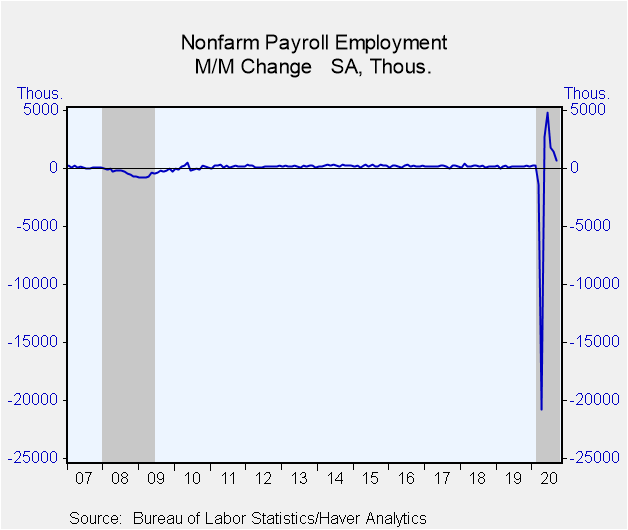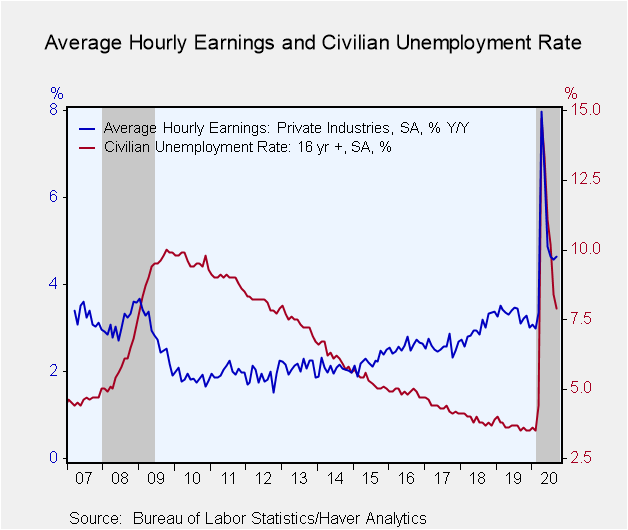 Global| Oct 02 2020
Global| Oct 02 2020U.S. Employment & Earnings Growth Weaken; Jobless Rate Declines
by:Tom Moeller
|in:Economy in Brief
Summary
• Private service-sector hiring slows. • Earnings growth eases. • Jobless rate declines to six-month low. Nonfarm payroll employment increased 661,000 during September (-6.4% y/y) after rising 1.489 million in August, revised from [...]
• Private service-sector hiring slows.
• Earnings growth eases.
• Jobless rate declines to six-month low.
Nonfarm payroll employment increased 661,000 during September (-6.4% y/y) after rising 1.489 million in August, revised from 1.371 million. July employment improved 1.761 million, revised from 1.734 million. Job growth has been positive for five consecutive months following sharp declines in the prior two months during the economic recession. An 840,000 employment increase had been expected in the Action Economics Forecast Survey. The estimates amongst 26 forecasters had ranged from 400,000 to 1.100 million.
Average hourly earnings growth slowed to 0.1% (4.7% y/y) after a 0.3% August gain, revised from 0.4%. A 0.2% gain in earnings had been expected.
The unemployment rate fell to 7.9% from 8.4%. An easing to 8.2% had been expected. Employment in the household survey increased 275,000 after rising 3.756 million in August while the labor force fell 695,000 after rising 968,000 in August. The overall jobless rate, including those who were marginally attached or working part-time for economic reasons, declined to 12.8% from 14.2%.
The employment & earnings data are collected from surveys taken each month during the week containing the 12th of the month. The labor market data are contained in Haver's USECON database. Detailed figures are in the EMPL and LABOR databases. The expectations figures are in the AS1REPNA database.
| Employment (SA, M/M Change, 000s) | Sep | Aug | Jul | Sep Y/Y | 2019 | 2018 | 2017 |
|---|---|---|---|---|---|---|---|
| Payroll Employment | 661 | 1,489 | 1,761 | -6.4% | 1.4% | 1.6% | 1.6% |
| Previous Estimate | -- | 1,371 | 1,734 | -- | -- | -- | -- |
| Manufacturing | 66 | 36 | 41 | -5.1 | 1.2 | 2.0 | 0.7 |
| Construction | 26 | 17 | 31 | -3.7 | 2.8 | 4.6 | 3.6 |
| Private Service-Producing | 784 | 977 | 1,460 | -7.2 | 1.5 | 1.5 | 1.8 |
| Government | -216 | 467 | 235 | -3.7 | 0.6 | 0.5 | 0.4 |
| Average Weekly Hours - Private Sector | 34.7 | 34.6 | 34.6 | 34.4 | 34.4 | 34.5 | 34.4 |
| Private Sector Average Hourly Earnings (%) | 0.1 | 0.3 | 0.1 | 4.7 | 3.3 | 3.0 | 2.6 |
| Unemployment Rate (%) | 7.9 | 8.4 | 10.2 | 3.5 | 3.7 | 3.9 | 4.3 |
Tom Moeller
AuthorMore in Author Profile »Prior to joining Haver Analytics in 2000, Mr. Moeller worked as the Economist at Chancellor Capital Management from 1985 to 1999. There, he developed comprehensive economic forecasts and interpreted economic data for equity and fixed income portfolio managers. Also at Chancellor, Mr. Moeller worked as an equity analyst and was responsible for researching and rating companies in the economically sensitive automobile and housing industries for investment in Chancellor’s equity portfolio. Prior to joining Chancellor, Mr. Moeller was an Economist at Citibank from 1979 to 1984. He also analyzed pricing behavior in the metals industry for the Council on Wage and Price Stability in Washington, D.C. In 1999, Mr. Moeller received the award for most accurate forecast from the Forecasters' Club of New York. From 1990 to 1992 he was President of the New York Association for Business Economists. Mr. Moeller earned an M.B.A. in Finance from Fordham University, where he graduated in 1987. He holds a Bachelor of Arts in Economics from George Washington University.








